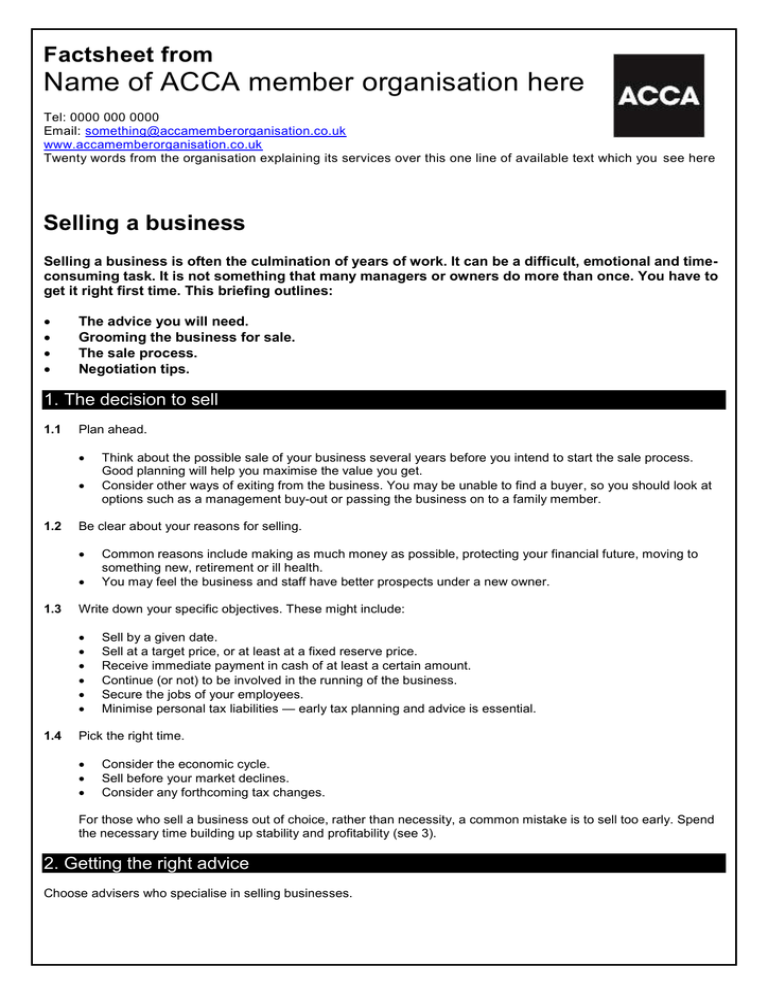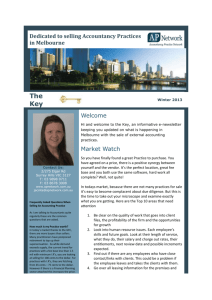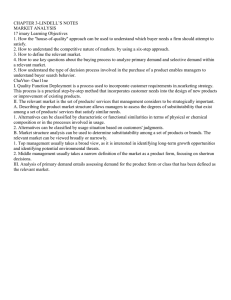BHP guide to... Selling a business
advertisement

Factsheet from Name of ACCA member organisation here Tel: 0000 000 0000 Email: something@accamemberorganisation.co.uk www.accamemberorganisation.co.uk Twenty words from the organisation explaining its services over this one line of available text which you see here Selling a business Selling a business is often the culmination of years of work. It can be a difficult, emotional and timeconsuming task. It is not something that many managers or owners do more than once. You have to get it right first time. This briefing outlines: The advice you will need. Grooming the business for sale. The sale process. Negotiation tips. 1. The decision to sell 1.1 Plan ahead. 1.2 Be clear about your reasons for selling. 1.3 Common reasons include making as much money as possible, protecting your financial future, moving to something new, retirement or ill health. You may feel the business and staff have better prospects under a new owner. Write down your specific objectives. These might include: 1.4 Think about the possible sale of your business several years before you intend to start the sale process. Good planning will help you maximise the value you get. Consider other ways of exiting from the business. You may be unable to find a buyer, so you should look at options such as a management buy-out or passing the business on to a family member. Sell by a given date. Sell at a target price, or at least at a fixed reserve price. Receive immediate payment in cash of at least a certain amount. Continue (or not) to be involved in the running of the business. Secure the jobs of your employees. Minimise personal tax liabilities — early tax planning and advice is essential. Pick the right time. Consider the economic cycle. Sell before your market declines. Consider any forthcoming tax changes. For those who sell a business out of choice, rather than necessity, a common mistake is to sell too early. Spend the necessary time building up stability and profitability (see 3). 2. Getting the right advice Choose advisers who specialise in selling businesses. 2.1 Good advisers can fill many roles, such as: 2.2 Consider using a combination of advisers to cover all aspects of selling. 2.3 A corporate finance adviser can help groom the business (see 3), identify buyers, and write the Sales Memorandum (see 4). A non-executive director can offer objective advice and support. A corporate lawyer can draft and negotiate the Sale Agreement. A tax accountant (or lawyer) can minimise your tax liabilities. Specialists can accurately value assets. Agree a clear fee structure. There are three main ways of charging fees: 2.4 Boosting your credibility and making negotiations go smoothly. Providing a realistic business valuation. Approaching potential buyers without revealing your identity. Widening the list of possible buyers. Allowing you to run the business while they concentrate on selling it. An hourly rate. Obtain an estimate of how many hours’ work is required. Agree an upper or a review limit, and the timing of interim fee statements. A fixed rate for a certain piece of work (eg drawing up the Sales Memorandum). A contingency fee dependent upon success and the eventual sale price. Divide responsibilities between advisers. The instruction and fee basis for each adviser should be clear and in writing. Avoid overlapping responsibilities, but seek second opinions on important issues. Agree the lines of communication and make sure each party knows its responsibilities for dealing with enquiries. Take care to define who is doing what and coordinate the process. Get key items of advice confirmed in writing. 3. Grooming the business Showing the business in the best light is a crucial factor in gaining the best possible price. 3.1 Create a good financial record. 3.2 Make sure management information systems are working smoothly. 3.3 Concentrate on short-term results. Try to show a stable financial pattern through the year. Delay or bring forward major purchases to help achieve this. Be realistic when using depreciation figures or the timing of income in your accounts. Provisions for bad debt and old stock should also be realistic. Sell under-used equipment and property. Improve your working capital position by good stock management and tighter credit control. Buyers will want information quickly. You need to show that the business is under control. Ensure the information is accurate. A buyer’s confidence will be undermined by errors. Present the assets in good condition. Premises and equipment should look well maintained. Stock should be neat and orderly. 2 3.4 Make the business less risky from the buyer’s point of view. Turn informal deals with suppliers and customers into formal contracts. Establish sensible incentive schemes to encourage key employees to remain with the business. Reduce dependence on a few large customers or a single source of supply. Tie up any loose ends. If your tenancy agreement is due to expire soon, make sure the landlord will agree a new one, preferably in writing. There are many ways to make a business shine, so it is always worth discussing with your adviser or nonexecutive directors. 4. Sales Memorandum The Sales Memorandum is the initial marketing document sent to interested parties. It is written jointly by the management and your corporate adviser. It should: 4.1 Make the business sound attractive. 4.2 Be a source of hard information for buyers. 4.3 Show that the business can be improved. This is particularly important when the buyer plans to be a hands-on manager. Keep detailed confidential information out of a Sales Memorandum. This can be shown later to serious buyers. 5. Marketing the business Marketing your business falls into six stages. 5.1 Find potential buyers, such as: 5.2 Competitors, suppliers or customers. New market entrants, including foreign companies. Your own management (a buyout) or another management team (a buyin). Financial investment companies. List possible buyers. This should involve no more than 30 names, divided into an A and a B list. Only use the B list if the A list does not produce results. 5.3 Approach the possible buyers to see if they are interested. Keep your own business anonymous by using an adviser. It is usual to approach a business through its adviser (eg the auditor), unless you have a better contact. The adviser can direct you to the appropriate person. If the business is run by an owner-manager, approach the individual directly. Use the phone, or a one-page letter. 5.4 Ask your legal adviser to draw up a short confidentiality agreement for interested buyers to sign before any discussions commence. 5.5 Send out the Sales Memorandum with: 3 5.6 An outline of the sale timetable. Details of where and when you would like to meet buyers. A request for opening offers. After receiving offers, draw up a shortlist of buyers. Reject buyers without the finance to make the purchase. The process of meeting buyers can be disruptive to managing and running your business. Balance the access you give buyers with maintaining confidentiality and productivity. 6. Weighing up the offers There are many ways of paying for and taking over a business. You will need to weigh up what is on offer. The most important things to consider are: 6.1 Can the buyer really pay for the business? 6.2 However good an offer may sound, unless it is properly financed, it is worthless. Buyers must have the right approvals (eg from the board or from shareholders). What form will payment take? Cash payment up front is the safest option but may also be the least tax efficient. If deferred cash payment is offered, establish whether it is guaranteed. It may be in the form of earn-outs which are linked to future sales or profits. In a situation where payments are reliant on the future performance of the business, make sure you retain some form of management control to enable performance targets to be met. Otherwise, you may receive less than you are entitled to. A share swap is only comparable to a cash payment if the shares you receive are in a quoted company. Make sure to check the tax implications. Shares in an unquoted company may be hard to value and difficult to sell. 6.3 What will your responsibilities and liabilities be? 6.4 How will the business be run in future? 6.5 You may be asked — or required — to remain involved in the business. But remember you will no longer be in control — consider whether you may find this difficult and frustrating. You will probably be tied to warranties and indemnities for a year or more. What expansion or sales plans does the buyer have? Will any parts of the business be sold off? How will the deal affect employees? Will anyone be made redundant? How long will completion of the sale take? Industry and accounting due diligence must be completed. This may include an accountant’s report. The accountant’s remit will be to verify the key management information and to identify potential problems for the buyer. Legal due diligence may take up more time — sometimes several months. 7. Choosing a buyer You should now finalise sale terms. 4 7.1 Be sure you fully understand everything you are signing for, eg any warranties or indemnities you will have to provide. 7.2 Play off one party against another so that they raise their offers. Be prepared to bluff. The buyers will negotiate, but are unlikely to pull out. 7.3 Choose the buyer you want to sell to. Discuss the deal only with this candidate. Do not try to negotiate better terms at this stage, as this would destroy any trust that is developing between you and the buyer. A good working relationship is important. Your goal now is to complete the deal without any hiccups. 7.4 Quickly agree Heads of Terms with the buyer. This is a signed agreement setting out the deal’s chief points. Parts may be legally binding. For example: An exclusivity period during which the seller cannot negotiate with anyone else. Payment of the buyer’s (or your) costs. 7.5 Tell other potential buyers that you have signed a Heads of Terms with the buyer. Keep at least one other buyer interested, as a back-up. 8. Completing the deal The buyer’s offer will be subject to further due diligence and to the detailed sale agreement. Provided that this due diligence is trouble free, and neither party has any surprises up its sleeve, the sale should now be relatively safe. 8.1 The further due diligence usually involves the buyer’s accountants and lawyers. The accountants will want to look at every aspect of the finances of the business. The lawyers will want to check that your business has full legal ownership of all key assets (eg property deeds and licensing contracts). They will also want to look at the legal relationships with customers, suppliers and employees. Many legal issues are covered by warranties and indemnities that you, as a vendor, will almost certainly be asked to sign. Read these carefully — they can be far reaching. 8.2 Certain members of your staff (eg Finance Director or Company Secretary) may have to be involved early on in the due diligence process. Be mindful of the feelings of your employees, especially when communicating your plans, as you may lose key members of staff if they fear their jobs are in jeopardy. Under EU rules, businesses with more than 50 employees have to notify and discuss, with their employees, any changes likely to affect their jobs. Penalties for non-compliance can be severe. Carefully consider who you tell and when you tell them. 8.3 Finalise the sale and purchase agreement. Getting your price Once you have received opening offers, start the bargaining process. A. Set a price. Decide what price you are likely to get. 5 B. Coax the remaining buyers into closer contact, keeping them well informed. C. Reject buyers who are significantly below this level. Offer them access to selected members of your team. Distribute positive business data, before the buyers ask for it. Be ready to counter negativity. Be open and transparent. Spur buyers into action. Ask for final offers. Tell them how much to raise their offers. Consistently emphasise the future business opportunities. Make it clear that other buyers are also seriously interested in the business. Setting and holding out for a high price usually pays off. Potential buyers will gain an impression of genuine selfconfidence. Experts’ quotes “Selling a business is a very distracting process for management. Be careful not to take your eye off the ball, or the performance of your business could deteriorate at the exact moment when the buyer is examining it.” Brian Hayden, Hayden Associates Expert contributors Thanks to Brian Hayden (Hayden Associates, 077 8553 2266). Last reviewed 01.02.12 © BHP Information Solutions 2012. ISSN 1369-1996. All rights reserved. No part of this publication may be reproduced or transmitted without the written permission of the publisher. This publication is for general guidance only. The publisher, expert contributors and distributor disclaim all liability for any errors or omissions. Consult your local business support organisation or your professional adviser for help and advice. 6



